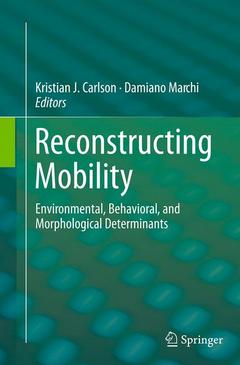Reconstructing Mobility, Softcover reprint of the original 1st ed. 2014 Environmental, Behavioral, and Morphological Determinants
Coordonnateurs : Carlson Kristian J., Marchi Damiano

Chapter 1: Introduction: Towards Refining the Concept of Mobility.- Chapter 2: Long Bone Structural Analyses and the Reconstruction of Past Mobility: A Historical Review.- Chapter 3: Bipedalism and Musculoskeletal Stress Markers: Variation and What it reveals About Adaptation, Environmental Stress, and Reconstructing Activity Patterns.- Chapter 4: Does the Distribution and Variation in Cortical Bone along Lower Limb Diaphyses Reflect Selection for Locomotor Economy?.- Chapter 5: Human Variation in the Periosteal Geometry of the Lower Limb: Signatures of Behaviour among Human Holocene Populations.- Chapter 6: The Importance of Considering Fibular Robusticity when Inferring the Mobility Patterns of Past Populations.- Chapter 7: The Relationship between Femur Shape and Terrestrial Mobility Patterns.- Chapter 8: Activity, Body Shape, and Cross-sectional Geometry of the Femur and Tibia.- Chapter 9: Variation in Mobility and Anatomical Responses in the Late Pleistocene.- Chapter 10: Femoral Diaphyseal Shape and Mobility: An Ontogenetic Perspective.- Chapter 11: The Balance between Burden Carrying, Variable Terrain and Thermoregulatory Pressures in Assessing Morphological Variation.- Chapter 12: Territory Size in Canis lupus: Implications for Neandertal Mobility.- Chapter 13: The Effects of Terrain on Long Bone Robusticity and Cross-sectional Shape in Lower Limb Bones of Bovids, Neandertals, and Upper Paleolithic Modern Humans.- Chapter 14: Linearity in the Real World – An Experimental Assessment of Non-linearity in Terrestrial Locomotion.- Chapter
15 Femoral Mechanics, Mobility, and Finite Element Analysis.-
15 Femoral Mechanics, Mobility, and Finite Element Analysis.-
Kristian Carlson received his PhD from Indiana University, Bloomington (USA) in 2002. Following this, he spent three years as a postdoctoral associate in the Department of Anatomical Sciences at Stony Brook University, NY (USA), and one year in a postdoctoral position in the Anthropologisches Institute and Museum at the University of Zürich (Switzerland). He was an Assistant Professor of Anatomy at the New York College of Osteopathic Medicine (USA) for two years before joining the Institute for Human Evolution (IHE) at the University of the Witwatersrand (South Africa) in 2009 as a Senior Researcher. His research interests include modelling form-function relationships in limb bones of primates, both extinct and extant. He utilizes a variety of approaches to tackle questions about the impact that behaviours have on skeletal form. These include experimental assessments of primate locomotion (i.e., kinematics and kinetics), focusing on transverse forces and the behaviours that accentuate them (e.g., turning); traditional comparative studies of ape limb bone cross-sectional properties, including leading analyses of habituated chimpanzee skeletons; and mouse model research aimed at testing the explicit predictions constructed from his work with primates. Ultimately the supported predictions from extant-based models are applicable to extinct primates, including hominins, in order to infer the nature of their behavioral repertoires, particularly the emphasis on arboreal locomotion in their evolutionary history.
Damiano Marchi received his PhD from the University of Pisa, Italy in 2004. From 2004 to 2010 he was Visiting Assistant Professor at Duke University, USA, teaching and conducting research on human and living primate locomotory postcranial functional morphology. From 2011 to 2012 he was a post-doctoral fellow at the Institute for Human Evolution, University of the Witwatersrand, South Africa. Since 2012 he is Lecturer of Anthropology at the Un
Presents a comprehensive overview of the different approaches used to study early human mobility
Puts forward a new, holistic approach to mobility that synthesizes intrinsic (i.e. skeletal) and extrinsic (i.e. environmental) factors
Investigates the structural expression of mobility in general rather than just in specific populations
Includes supplementary material: sn.pub/extras
Date de parution : 09-2016
Ouvrage de 295 p.
15.5x23.5 cm
Disponible chez l'éditeur (délai d'approvisionnement : 15 jours).
Prix indicatif 158,24 €
Ajouter au panierDate de parution : 08-2014
Ouvrage de 295 p.
15.5x23.5 cm
Disponible chez l'éditeur (délai d'approvisionnement : 15 jours).
Prix indicatif 158,24 €
Ajouter au panierThèmes de Reconstructing Mobility :
Mots-clés :
activity patterns; biomechanics; bone functional adaptation; human evolution; locomotion; posture
